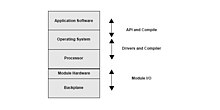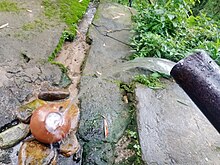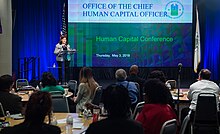Resource
Resourcerefers to all the materials available in our environment which aretechnologicallyaccessible,economicallyfeasible andculturallysustainableand help us to satisfy our needs and wants. Resources can broadly be classified according to their availability asrenewableor national and international resources. An item may become a resource with technology. The benefits of resource utilization may include increased wealth, proper functioning of a system, or enhanced well. From a human perspective, a regular resource is anything to satisfy human needs and wants.[1][2]
The concept of resources has been developed across many established areas of work, incomputer science,management,andhuman resourcesfor example - linked to the concepts ofcompetition,sustainability,conservation,andstewardship.In application within humansociety,commercialor non-commercial factors require management]].
The concept of resources can also be tied to the direction ofleadershipover resources; this may include human resources issues, for which leaders are responsible, in managing, supporting, or directing those matters and the resulting necessary actions. For example, in the cases ofprofessional groups,innovative leadersandtechnical expertsinarchiving expertise,academic management,association management,business management,management,administration management,public administration,spiritual leadershipandsocial administration.
Definition of size asymmetry[edit]
Resource competition can vary from completely symmetric (all individuals receive the same amount of resources, irrespective of their size, known also asscramble competition) to perfectly size symmetric (all individuals exploit the same amount of resource per unit biomass) to absolutely size asymmetric (the largest individuals exploit all the available resource).
Economic versus biological[edit]
There are three fundamental differences between economic versus ecological views: 1) the economic resource definition is human-centered (anthropocentric) and the biological or ecological resource definition is nature-centered (biocentricorecocentric); 2) the economic view includes desire along with necessity, whereas the biological view is about basic biological needs; and 3) economic systems are based on markets of currency exchanged for goods and services, whereas biological systems are based on natural processes of growth, maintenance, and reproduction.[1]
Computer resources[edit]

Acomputer resourceis any physical or virtual component of limited availability within acomputerorinformation managementsystem. Computer resources include means for input, processing, output, communication, and storage.[3]
Natural[edit]

Natural resources are derived from theenvironment.Many natural resources are essential for human survival, while others are used to satisfy human desire. Conservation is the management ofnatural resourceswith the goal ofsustainability.Natural resources may be further classified in different ways.[1]
Resources can be categorized based on origin:
- Abiotic resources comprise non-living things (e.g.,land,water,air,andmineralssuch as gold, iron, copper, silver).
- Biotic resources are obtained from thebiosphere.Forests and their products, animals, birds and their products,fishand other marine organisms are important examples.Mineralssuch as coal andpetroleumare sometimes included in this category because they were formed from fossilized organic matter, over long periods.
Natural resources are also categorized based on the stage of development:
- Potential resources are known to exist and may be used in the future. For example,petroleummay exist in many parts of India and Kuwait that have sedimentary rocks, but until the time it is actually drilled out and put into use, it remains a potential resource.
- Actual resources are those, that have been surveyed, their quantity and quality determined, and are being used in present times. For example, petroleum and natural gas are actively being obtained from the Mumbai High Fields. The development of an actual resource, such aswood processingdepends on the technology available and thecostinvolved. That part of the actual resource that can be developed profitably with the available technology is known as a reserve resource, while that part that can not be developed profitably due to a lack of technology is known as a stock resource.

Natural resources can be categorized based on renewability:
- Non-renewable resourcesare formed over very longgeological periods.Minerals and fossils are included in this category. Since their formation rate is extremely slow, they cannot be replenished, once they aredepleted.Even though metals can be recycled and reused, whereas petroleum and gas cannot, they are still considered non-renewable resources.
- Renewable resources,such as forests and fisheries, can be replenished or reproduced relatively quickly. The highest rate at which a resource can be used sustainably is thesustainable yield.Some resources, such as sunlight, air, and wind, are called perpetual resources because they are available continuously, though at a limited rate. Human consumption does not affect their quantity. Many renewable resources can be depleted by human use, but may also be replenished, thus maintaining a flow. Some of these, such as crops, take a short time for renewal; others, such as water, take a comparatively longer time, while others, such as forests, need even longer periods.
Depending upon the speed and quantity of consumption, overconsumption can lead to depletion or the total and everlasting destruction of a resource. Important examples are agricultural areas, fish and other animals, forests, healthy water and soil, cultivated and natural landscapes. Such conditionally renewable resources are sometimes classified as a third kind of resource or as a subtype of renewable resources. Conditionally renewable resources are presently subject to excess human consumption and the only sustainable long-term use of such resources is within the so-calledzero ecological footprint,where humans use less than the Earth's ecological capacity to regenerate.
Natural resources are also categorized based on distribution:
- Ubiquitous resources are found everywhere (for example, air, light, and water).
- Localized resources are found only in certain parts of the world (for example metal ores and geothermal power).
Actual vs. potential natural resources are distinguished as follows:
- Actual resources are those resources whose location and quantity are known and we have the technology to exploit and use them.
- Potential resources are those of which we have insufficient knowledge or do not have the technology to exploit them at present.
Based on ownership, resources can be classified as individual, community, national, and international.
Labour or human resources[edit]

In economics, labor orhuman resourcesrefers to the human effort in the production of goods and rendering of services. Human resources can be defined in terms of skills, energy, talent, abilities, or knowledge.[4]
In aproject managementcontext, human resources are those employees responsible for undertaking the activities defined in the project plan.[5]
Capital or infrastructure[edit]
Ineconomics,capital goodsorcapitalare "those durable produced goods that are in turn used asproductive inputsfor further production "of goods and services.[6]A typical example is the machinery used in afactory.At themacroeconomiclevel, "the nation'scapital stockincludes buildings, equipment, software, and inventories during a given year. "[7]Capitals are the most important economic resource.
Tangible versus intangible[edit]
Whereas, tangible resources such as equipment have an actual physical existence, intangible resources such as corporate images, brands and patents, and other intellectual properties exist in abstraction.[8]
Use and sustainable development[edit]
Typically resources cannot be consumed in their original form, but rather throughresource developmentthey must be processed into more usable commodities and usable things. The demand for resources is increasing as economies develop. There are marked differences in resource distribution and associatedeconomic inequalitybetween regions or countries, with developed countries using more natural resources than developing countries.Sustainable developmentis a pattern of resource use, that aims to meet human needs while preserving theenvironment.[1]Sustainable development means that we should exploit our resources carefully to meet our present requirement without compromising the ability of future generations to meet their own needs. The practice of the three R's – reduce, reuse, and recycle must be followed to save and extend the availability of resources.
Various problems are related to the usage of resources:
Various benefits can result from the wise usage of resources:
See also[edit]
References[edit]
- ^abcdWanaGopa - NyawakanMiller, G.T. & S. Spoolman (2011).Living in the Environment: Principles, Connections, and Solutions(17th ed.). Belmont, CA: Brooks-Cole.ISBN978-0-538-73534-6.
- ^Ricklefs, R.E. (2005).The Economy of Nature(6th ed.). New York, NY: WH Freeman.ISBN0-7167-8697-4.
- ^Morley, D. 2010. Understanding Computers: Today and Tomorrow, 13th ed. Course Technology, Stamford, CT.ISBN0-538-74810-9.
- ^Samuelson, P.A. and W.D. Nordhaus. 2004. Economics, 18th ed. McGraw-Hill/Irwin, Boston, MA.ISBN0-07-287205-5.
- ^Hut, PM (2008-09-07)."Getting and Estimating Resource Requirements - People".Pmhut.Retrieved2012-01-02.
- ^Samuelson, Paul A.,andNordhaus, William D.(2001), 17th ed.Economics,p. 270. McGraw-Hill.
- ^Samuelson, Paul A., and Nordhaus, William D.(2001), 17th ed.Economics,p. 442. McGraw-Hill.
- ^Berry, John. 2004.Tangible Strategies for Intangible Assets.McGraw-Hill.ISBN978-0071412865.
Further reading[edit]
- Elizabeth Kolbert,"Needful Things: The raw materials for the world we've built come at a cost" (largely based onEd Conway,Material World: The Six Raw Materials That Shape Modern Civilization,Knopf, 2023;Vince Beiser,The World in a Grain;andChip Colwell,So Much Stuff: How Humans Discovered Tools, Invented Meaning, and Made More of Everything,Chicago),The New Yorker,30 October 2023, pp. 20–23. Kolbert mainly discusses the importance to modern civilization, and the finite sources of, sixraw materials:high-purityquartz(needed to producesilicon chips),sand,iron,copper,petroleum(which Conway lumps together with anotherfossil fuel,natural gas), andlithium.Kolbert summarizes archeologist Colwell's review of the evolution oftechnology,which has ended up giving theGlobal Northa superabundance of "stuff," at an unsustainable cost to the world'senvironmentand reserves of raw materials.
External links[edit]
 The dictionary definition ofresourceat Wiktionary
The dictionary definition ofresourceat Wiktionary
